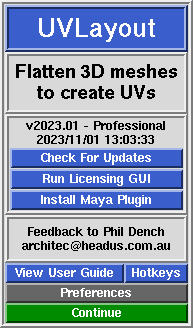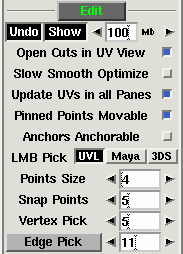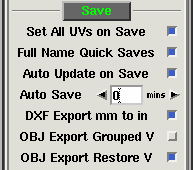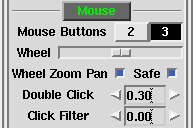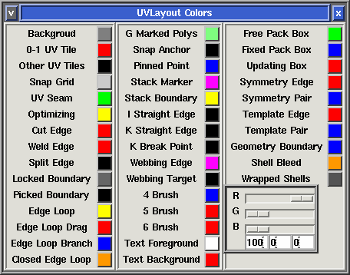User Guide: About UVLayout
From UVLayout Docs
| Revision as of 03:50, 22 July 2021 (edit) Headus (Talk | contribs) (→Save Settings) ← Previous diff |
Current revision (01:18, 13 November 2025) (edit) (undo) Headus (Talk | contribs) |
||
| (18 intermediate revisions not shown.) | |||
| Line 1: | Line 1: | ||
| __NOTOC__ {{:User Guide: Menu}} UVLayout is a stand-alone application for the creation and editing of UV coordinates for 3D polymeshes and subdivision surfaces. Used by professionals in the games and visual effects industries, by hobbyists of all ilks and by students, UVLayout's unique approach gives texture artists the tools they need to produce high quality low distortion UVs in significantly less time than they would by traditional methods. | __NOTOC__ {{:User Guide: Menu}} UVLayout is a stand-alone application for the creation and editing of UV coordinates for 3D polymeshes and subdivision surfaces. Used by professionals in the games and visual effects industries, by hobbyists of all ilks and by students, UVLayout's unique approach gives texture artists the tools they need to produce high quality low distortion UVs in significantly less time than they would by traditional methods. | ||
| - | Over the following pages the UVLayout GUI will be described, working from the top to the bottom of the main window. Use the menu to the left to move through the various chapters. If you want to jump right into using UVLayout, you should at least read the [[User Guide: Quick Start|Quick Start]] chapter. | + | '''If you want to jump right into using UVLayout, you should at least read the [[User Guide: Quick Start|Quick Start]] and [[User Guide: Hotkeys#Main Hotkeys|Main Hotkeys]] chapters.''' |
| + | |||
| + | Over the following pages the UVLayout GUI will be described, working from the top to the bottom of the main window. Use the menu to the left to move through the various chapters. | ||
| '''Note:''' Sections tagged with a {{Pro}} label describe features only available in the Professional version of UVLayout. Click on the {{Pro2|pro0|User_Guide:_Display#pro2}} link to cycle through these sections. | '''Note:''' Sections tagged with a {{Pro}} label describe features only available in the Professional version of UVLayout. Click on the {{Pro2|pro0|User_Guide:_Display#pro2}} link to cycle through these sections. | ||
| Line 13: | Line 15: | ||
| ;Pin : Click on the gray button to the left to pin/save the current window position and size; UVLayout will then open up like that until a new shape is set. | ;Pin : Click on the gray button to the left to pin/save the current window position and size; UVLayout will then open up like that until a new shape is set. | ||
| - | ;About UVLayout : Click on About UVLayout to find the application version and build date, to check for updates, to view the User Guide, and to change some preferences. See below for details. | + | ;About UVLayout : Click on About UVLayout to find the application version and build date, to check for updates, to view the User Guide, and to change some preferences. See below for details. '''MMB''' click'n'drag the button to move the main GUI window around. |
| ;Max : Click on the gray button to the right to maximize the open windows; this moves the main GUI to the top left, and expands the graphics window to fill the remainder if the screen. Click the maximize button again to restore the previous window positions. | ;Max : Click on the gray button to the right to maximize the open windows; this moves the main GUI to the top left, and expands the graphics window to fill the remainder if the screen. Click the maximize button again to restore the previous window positions. | ||
| Line 36: | Line 38: | ||
| ; Hotkeys : This opens up a window that shows a list of the most common hotkeys used in UVLayout. | ; Hotkeys : This opens up a window that shows a list of the most common hotkeys used in UVLayout. | ||
| + | |||
| + | {{PageBreak}} | ||
| == Preferences == | == Preferences == | ||
| Line 53: | Line 57: | ||
| :; Trace Max Rez : When using the '''Display''' panel's '''Trace''' feature, the map you select is reduced to this size. If you have a modern graphics adapter with a large amount of texture memory, you can probably increase this value to get sharper looking background images. | :; Trace Max Rez : When using the '''Display''' panel's '''Trace''' feature, the map you select is reduced to this size. If you have a modern graphics adapter with a large amount of texture memory, you can probably increase this value to get sharper looking background images. | ||
| - | :; Free CPU Cores : For tools that can utilize multiple CPU cores, this preference tells UVLayout how many CPU cores you want left free for other work you might want to do. Set it to '''0''' and UVLayout will use all cores. | + | :; Max Threads : For tools that can utilize multiple CPU cores, this preference tells UVLayout how many threads to start up for the processing. |
| :; Local Temp Files : When OBJ files are loaded or saved, temporary files are created as the geometry is converted from and to UVLayout's native format. By default these temp files are created in system temporary folders, but if you tick this option, they will be created in the same folder as the file being loaded or saved. If you're experiencing problems loading an OBJ, or saved OBJs are zero sized, turning this on may fix that. | :; Local Temp Files : When OBJ files are loaded or saved, temporary files are created as the geometry is converted from and to UVLayout's native format. By default these temp files are created in system temporary folders, but if you tick this option, they will be created in the same folder as the file being loaded or saved. If you're experiencing problems loading an OBJ, or saved OBJs are zero sized, turning this on may fix that. | ||
| + | |||
| + | :; Beta or Low Doc Code : Enables experimental or undocumented tools. | ||
| === Load Settings === | === Load Settings === | ||
| Line 85: | Line 91: | ||
| [[Image:UserGuide-Pref-Edit.png|right|]] | [[Image:UserGuide-Pref-Edit.png|right|]] | ||
| - | :::; Undo Show : By default, Ctrl-Z Undo is enabled; the code is quite new and not extensively tested, so if you experience problems with it, click on the Undo button to turn it off. When Undo is enabled, the name of the previous action is displayed towards the top right of the graphics window, along with a small bar that indicates how full the Undo buffer is; to hide this information, click on the Show button to turn it off. The Undo buffer starts off at 100Mb, which means that UVLayout will use up to this amount of RAM when saving the undo restore information; if you are on a system with limited RAM, you may want to reduce this number, and conversely, increasing it on a larger system will give you more levels of undo. | + | :::; Undo Show : When Undo is enabled, the name of the previous action is displayed towards the top right of the graphics window, along with a small bar that indicates how full the Undo buffer is; to hide this information, click on the Show button to turn it off. The Undo buffer starts off at 100Mb, which means that UVLayout will use up to this amount of RAM when saving the undo restore information; if you are on a system with limited RAM, you may want to reduce this number, and conversely, increasing it on a larger system will give you more levels of undo. |
| :::; Open Cuts in UV View : By default this is on, and it means that when you make '''C''' hotkey cuts in the UV view, the UVs pull apart slightly to create a gap. Turning this off means that the cuts will not open up. | :::; Open Cuts in UV View : By default this is on, and it means that when you make '''C''' hotkey cuts in the UV view, the UVs pull apart slightly to create a gap. Turning this off means that the cuts will not open up. | ||
| Line 99: | Line 105: | ||
| :::; LMB Pick : Choose your preferred method for left mouse button picking of shells in the UV view. Either original UVLayout flavor, or Maya, or 3DS Max picking methods. | :::; LMB Pick : Choose your preferred method for left mouse button picking of shells in the UV view. Either original UVLayout flavor, or Maya, or 3DS Max picking methods. | ||
| - | :::; Snap Points : Sets the distance in pixels for UV point to point snapping. | + | :::; Points Size : Sets the size in pixels of tagged points. |
| - | :::; Pick Safety : Sets the number of pixels from a vertex before an edge becomes selectable. | + | :::; Vertex Pick : Sets the number of pixels from a vertex before an edge becomes selectable. |
| - | :::; Max U : Where tile udims are displayed or used in any way, this preference selects how those tile numbers are calculated. The first setting is the maximum number of columns, and the default of '''10''' is the industry standard. The second setting is the number of the first unit tile, and '''1001''' again is the standard value, but can be changed if required. | + | :::; Edge Pick : Sets the pixel width of the edge picking region. If you have a mesh loaded and are in the UV view, a rectangle will be drawn along edges as visual feedback while this value is being adjusted. Click the '''Edge Pick''' button to toggle the display of this feedback graphic at all times. |
| - | :::; 1st : Where tile U and V values are displayed or used, this preference selects what numbers are given to the first unit tile. Typically this will be either '''0,0''' or '''1,1'''. | + | :::; M / Shift-M : Normally the '''M''' hotkey is used to ''magnetically'' snap shells together before they are welded. Originally '''M''' was used to snap the shell under the cursor away to the location of the adjacent shell, where '''Shift-M''' would move the adjacent shells so they fall alongside the shell under the cursor. This option swaps the action of the '''M''' and '''Shift-M''' hotkeys. |
| + | |||
| + | :::; Shift MMB : The original method for moving UV points with the brush was "lossy" in the sense that if you moved the brush to one side then moved the brush back to its original location, the UVs didn't go back to exactly where they were. The new method fixes this. | ||
| + | |||
| + | :::; G / H Select : When using the LMB to select points, polygons or shells, choose between a simple rectangle selection or an editable polygon selection. | ||
| + | |||
| + | :::; A / O Hotkey : With this setting you can decide if the '''A''' hotkey is used for setting anchor points and '''O''' for picking points ('''Orig''') or if you want it the other way around ('''Swap'''). | ||
| === Save Settings === | === Save Settings === | ||
| Line 123: | Line 135: | ||
| :::; OBJ Export Grouped V : By default, all vertex information is written into exported OBJs at the start of the file. If you tick this option, then the vertexes are grouped in with the faces; this resolves problems that might occur if the vertexes are grouped separately to the faces when importing into Maya. | :::; OBJ Export Grouped V : By default, all vertex information is written into exported OBJs at the start of the file. If you tick this option, then the vertexes are grouped in with the faces; this resolves problems that might occur if the vertexes are grouped separately to the faces when importing into Maya. | ||
| - | :::; OBJ Export Restore V : By default, the vertexes of exported OBJ files may be very slightly offset from the original vertex positions. To fix this, turn on this option to preserve exactly the coordinate values from the original imported OBJ. x | + | :::; OBJ Export Restore V : By default, the vertexes of exported OBJ files may be very slightly offset from the original vertex positions. To fix this, turn on this option to preserve exactly the coordinate values from the original imported OBJ. |
| === Mouse Settings === | === Mouse Settings === | ||
| Line 133: | Line 145: | ||
| :::; Wheel Slider : Move the slider to the right to increase the power of a wheel mouse's zoom function. Move it to the left to decrease the power, and go all the way to the left to turn off the zoom function completely. | :::; Wheel Slider : Move the slider to the right to increase the power of a wheel mouse's zoom function. Move it to the left to decrease the power, and go all the way to the left to turn off the zoom function completely. | ||
| - | :::; Pan on Wheel Zoom : When this option is ticked, the view will pan as well as zoom, shifting the view focus to the section of the model that the mouse cursor is aiming at. Most other 3D applications just zoom about the center of the window, so if you prefer that, untick this option. | + | :::; Wheel Zoom Pan : When this option is ticked, the view will pan as well as zoom when using the mouse scroll wheel, shifting the view focus to the section of the model that the mouse cursor is aiming at. Most other 3D applications just zoom about the center of the window, so if you prefer that, untick this option. |
| + | |||
| + | :::; Safe : When ticked, the Zoom Pan function is tweaked to reduce the chances of getting lost. | ||
| :::; Double Click : Under OS X and Linux, this sets the double click speed, in seconds, for navigation actions in the file selection windows. If, for example, you are having problems double clicking a file to open it in the UVLayout Load window, then increase this setting. Under Windows you would need to use the standard Windows Mouse control panel to adjust the double click speed. | :::; Double Click : Under OS X and Linux, this sets the double click speed, in seconds, for navigation actions in the file selection windows. If, for example, you are having problems double clicking a file to open it in the UVLayout Load window, then increase this setting. Under Windows you would need to use the standard Windows Mouse control panel to adjust the double click speed. | ||
| Line 153: | Line 167: | ||
| :::; File List Rows : Sets the number of files/folders displayed in the file selection dialogs. | :::; File List Rows : Sets the number of files/folders displayed in the file selection dialogs. | ||
| + | <!-- | ||
| :::; GUI Always on Top : Turn this on to force the GUI windows to always stay on top of the 3D window if they're overlapping. ''Linux and Mac OS X only.'' | :::; GUI Always on Top : Turn this on to force the GUI windows to always stay on top of the 3D window if they're overlapping. ''Linux and Mac OS X only.'' | ||
| - | + | --> | |
| :::; Keyboard Event Push : By default, UVLayout will automatically push keyboard events between the GUI and graphics windows. This allows you to press a button in the GUI, then move the mouse pointer to the graphics window and use a keyboard hotkey without first having to select that window. You can turn that off with this preference, but there wouldn't be any reason to do this normally. ''Windows only''. | :::; Keyboard Event Push : By default, UVLayout will automatically push keyboard events between the GUI and graphics windows. This allows you to press a button in the GUI, then move the mouse pointer to the graphics window and use a keyboard hotkey without first having to select that window. You can turn that off with this preference, but there wouldn't be any reason to do this normally. ''Windows only''. | ||
| - | :::; Double Buffer Only : To help speed up some actions, UVLayout will occasionally draw into the front display buffer. On some OS/hardware combinations though, drawing into the front buffer can cause problems. If you notice odd things happening in the display window, then turn this option on. ''On Mac OS X systems, this is on by default, and shouldn't be turned off''. | + | :::; Bigger GUI : Turn this on to increase the size of the GUI for high resolution displays. ''Linux only''. |
| :::; Screen Height : When opening up a GUI panel, UVLayout will float it instead if the normal opening would make the main GUI taller than the screen height. On OS X and Linux systems, sometimes the automatic screen height calculation is wrong; here you can set the Screen Height preference to the correct value. | :::; Screen Height : When opening up a GUI panel, UVLayout will float it instead if the normal opening would make the main GUI taller than the screen height. On OS X and Linux systems, sometimes the automatic screen height calculation is wrong; here you can set the Screen Height preference to the correct value. | ||
| Line 166: | Line 181: | ||
| [[Image:UserGuide-Pref-Colors.png|right]] | [[Image:UserGuide-Pref-Colors.png|right]] | ||
| - | :::; Edit Colors : Click this button to pop up the color preferences panel. Click on any of the colored buttons to adjust the RGB sliders. Click the '''Reset''' button to return all colors to their default values. | + | :::; Workspace Colors : Click this button to pop up the color preferences panel. Click on any of the colored buttons to adjust the RGB sliders or percentage values. Click the '''Reset''' button to return all colors to their default values. |
| + | |||
| + | :::; Theme : Choose between the original Bold or Dark or Light color themes for the main GUI panels. | ||
| + | |||
| + | :::; Double Buffer Always : In earlier versions of UVLayout the default was to mix double buffer and direct front buffer drawing. For better performance and compatibility with modern GPUs/drivers, double buffer drawing is now always used and is the default setting. This option to turn it off will likely go away at some point. | ||
| + | |||
| + | :::; Display Speed Boost : Added in v2025.2, the speed boost mode produces quicker redraws for smoother view changes, especially noticeable with dense meshes. You'll only want to turn this off if something isn't drawing properly and you want to go back to the "old slow mode". In that event, please email us a bug report. | ||
| + | |||
| + | :::; FPS Limit : Set the "frames per second" redraw rate here. | ||
| + | |||
| + | :::; Picking Speed Boost : Added in v2025.2, this produces quicker picks (e.g. tagging edges for cuts or welds), and again is particularly better than the old code for dense meshes. This can't be turned off if Display Speed Boost in on. | ||
Current revision
|
UVLayout is a stand-alone application for the creation and editing of UV coordinates for 3D polymeshes and subdivision surfaces. Used by professionals in the games and visual effects industries, by hobbyists of all ilks and by students, UVLayout's unique approach gives texture artists the tools they need to produce high quality low distortion UVs in significantly less time than they would by traditional methods.
If you want to jump right into using UVLayout, you should at least read the Quick Start and Main Hotkeys chapters. Over the following pages the UVLayout GUI will be described, working from the top to the bottom of the main window. Use the menu to the left to move through the various chapters. Note: Sections tagged with a [Professional Version Only] label describe features only available in the Professional version of UVLayout. Click on the [Professional Version Only] link to cycle through these sections. The top row of the UVLayout main window (see image right) consists of three buttons:
When you click on the About UVLayout button a window (see image right) pops up, showing the version and build date of the UVLayout that you are currently running.
PreferencesClick on the Preferences button to open up the preferences panel. In there are a number of settings you can change that will be remembered next time you run UVLayout.
Load Settings
Edit Settings
Save Settings
Mouse Settings
GUI Settings
|

